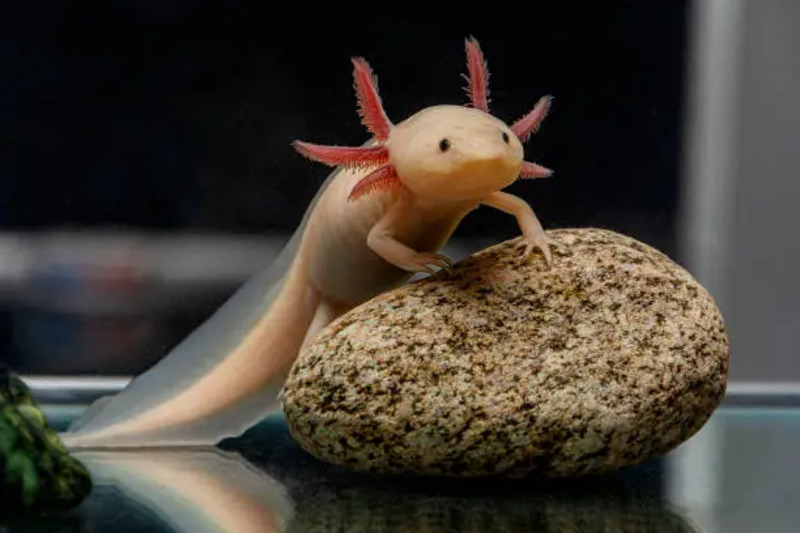
Axolotl as Pets
Published on June 26, 2025
The axolotl (Ambystoma mexicanum) is a fascinating and unique amphibian that has captured the hearts of many exotic pet enthusiasts. Native to the lakes of Mexico, these salamanders are renowned for their perpetual larval state, meaning they retain their juvenile features, including external gills and an aquatic lifestyle, throughout their lives. Their endearing 'smile' and regenerative abilities make them truly captivating creatures. However, owning an axolotl is a significant commitment, and understanding their specific needs is crucial for their well-being.
If you're considering bringing one of these incredible amphibians into your home, this guide will help you understand what it takes to be a responsible axolotl owner.
Are Axolotls the Right Pet for You?
Axolotls are not typical pets. They are relatively low-maintenance once their habitat is established, but they have very specific requirements that must be met. They are best suited for owners who are prepared for:
- Long Lifespan: With proper care, axolotls can live for 10-15 years, sometimes even longer.
- Specific Water Parameters: They are highly sensitive to water quality and temperature.
- No Handling: Axolotls have delicate skin and external gills, making them unsuitable for frequent handling. They are primarily display pets.
- Carnivorous Diet: They require a diet of live or frozen protein.
Setting Up the Ideal Habitat
A proper aquarium setup is paramount for an axolotl's health.
- Tank Size: A single axolotl needs at least a 10-gallon tank, but a 20-gallon long tank is highly recommended for better water stability. For each additional axolotl, add another 10 gallons.
- Water Temperature: This is critical. Axolotls thrive in cool water, ideally between 60-68°F (16-20°C). Temperatures above 72°F (22°C) can cause severe stress and health issues. A chiller or fan may be necessary in warmer climates.
- Filtration: A sponge filter or a low-flow hang-on-back (HOB) filter with a baffle is ideal. Strong currents can stress axolotls.
- Substrate: Bare bottom is safest to prevent impaction. If using substrate, it must be fine sand (for adults only) or large, smooth rocks too big to swallow. Gravel is a major impaction risk.
- Decorations: Provide plenty of hides (caves, PVC pipes) and live or silk plants for enrichment and security.
- Lighting: Axolotls prefer dim lighting. Avoid bright lights, which can stress them.
Water Quality: The Most Important Factor
Axolotls produce a lot of waste, making excellent water quality essential. You will need a reliable water testing kit to monitor:
- Ammonia, Nitrite, Nitrate: Ammonia and nitrite should always be 0 ppm. Nitrates should be kept below 20 ppm through regular water changes.
- pH: Maintain a pH between 6.5 and 8.0, ideally around 7.0-7.5.
- Chlorine/Chloramines: Always use a dechlorinator when adding tap water.
Perform weekly partial water changes (20-30%) to keep parameters stable.
Diet and Feeding
Axolotls are carnivores. Their diet should consist of high-quality protein sources:
- Primary Diet: Sinking pellets specifically formulated for axolotls or salamanders.
- Supplements: Bloodworms (frozen or live), earthworms (from a safe source, not wild-caught), brine shrimp, and small pieces of lean meat (occasionally).
Feed adult axolotls every 2-3 days. Juveniles may need to be fed daily.
Health and Regeneration
Axolotls are known for their incredible regenerative abilities, capable of regrowing limbs, gills, and even parts of their brain and heart. However, this doesn't mean they are immune to illness. Common issues include fungal infections (often due to poor water quality) and impaction from ingesting unsuitable substrate.
Always observe your axolotl for changes in behavior, appetite, or appearance. If you suspect illness, consult a veterinarian experienced with amphibians.
Conclusion
Owning an axolotl is a unique and rewarding experience. While they require specific care, providing them with the right environment and diet will ensure they thrive. Their calm demeanor and fascinating biology make them truly captivating display pets that can bring years of enjoyment to the dedicated amphibian enthusiast.